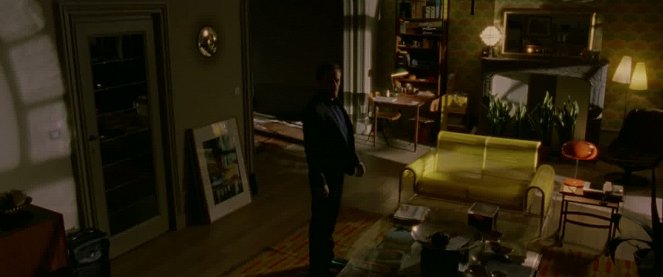Kamera:
Manuel DacosseBesetzung:
Klaus Tange, Ursula Bedena, Joe Koener, Birgit Yew, Anna D'Annunzio, Sam Louwyck, Jean-Michel Vovk, Sylvia Camarda, Hans De Munter, Romain RollInhalte(1)
Als ein Mann von einer Geschäftsreise nach Brüssel heimkehrt, ist seine Ehefrau spurlos verschwunden. Hat sie ihn verlassen? Ist es zu einem Verbrechen gekommen? Er begibt sich auf eine albtraumhafte Odyssee durch das labyrinthischen Whonkomplex, der ihn tief in Fantasien von Sinnlichkeit, Erotik und Gewalt eintauchen lässt. Nach dem international gefeierten Geniestreich AMER fackeln das Regieduo Cattet & Forzani ein zweites audiovisuelles Feuerwerk ab, das furios geschnitten mit den Stilmitteln eines Neo-Giallo psychosexuelle Abgründe ausleuchtet. (Drop-Out Cinema)
(mehr)Videos (2)
Kritiken (5)
Ein wichtiger Bestandteil eines jeden Giallos war eine verworrene Detektivgeschichte. Zumindest war das in den 70er Jahren so. Die neue Zeit scheint jedoch ein aufmerksameres Publikum zu haben, was einen viel komplizierteren Ansatz erfordert. Und hier haben Sie ihn auf einem Silbertablett! Die Macher des magischen "Amer" haben zwar ihren Ruf als surrealistische Maler der Leinwand bestätigt, aber dort, wo ihr vorheriges Werk "lesbar" war, erinnert dieser Versuch eher an einen Albtraum. In ihrem Labyrinth voller Rückblenden (?), Träume (??), bizarren Szenen und raffiniert verwirrenden Nebenwegen verlieren Sie sich leicht und schnell ohne Kompass. Besonders, wenn das Ende Sie in diesem ständigen Zweifel ertrinken lässt. Aber diese visuelle Darstellung ...!! Die visuelle Darstellung raubt einem erneut den Atem. Diese Details, diese Farben, diese Klänge, diese Musik (wieder Nicolai, Ortolani oder Morriconne), das ist genau der Grund, warum man Cattet und Forzani lieben oder zumindest bewundern sollte. Das Kino hat daher einen enormen Vorteil, zu Hause wird der Film wohl nicht diese vaginale Aufladung haben.
()
Der Film ist eine Zusammenstellung audiovisuell aufwändiger Szenen, die das Regie-Duo drehen wollte. Mit eindringlichen Geräuschen und aufwändigen Bildern attackiert der Film regelrecht die Sinne des Zuschauers. Wenn jedoch jemand anhand von Der Tod weint rote Tränen auch eine ebenso komplexe Handlung erwartet hat, wird er enttäuscht sein - denn hier gibt es praktisch keine Handlung. Es handelt sich um einen Film, bei dem ich beide Extreme der Bewertung verstehe. Leider habe ich die Mitternachtsvorführung regelrecht durchgestanden, ich saß im Sessel und quälte mich, die hundert Minuten schienen mir wie lange Stunden und anstatt eines qualitativen Erlebnisses nahm ich lediglich starke Kopfschmerzen mit. Das Duo Hélène Cattet und Bruno Forzani werde ich nächstes Mal lieber meiden.
()
Ein mysteriöses Mosaik von Halluzinationen, die etwas für den einfachen Plot ("einem Mann verschwindet aus einem von innen abgeschlossenen Appartement seine Frau“) bedeuten können, müssen es aber nicht. Ein schneller Schnitt, eine Traumverrücktheit mit unbegründeten erotischen Szenen und Gore. Am Anfang sieht es interessant aus, als Ganzes sorgt es aber für keine Begeisterung. Die Szenen, welche das Rätsel weiterentwickeln, könnte man in einen 10-minütigen Kurzfilm mit Stil packen.
()
A film like a Rubik’s Cube composed of giallo ornaments which, however, viewers are not supposed to piece together, but instead only immerse themselves in it and wander in its seams.
()
Behind the painting. When one of the characters drills through a head in an Art Nouveau painting and uncovers a deadly secret behind it, the viewer is forced to go beyond the surface of the film image - the horror genre may be profoundly absurd when it comes to meaning, but it is very close to overcoming the image in terms of techniques and effects. Just like in Amer, perhaps the main unifying element here is the evocation of a material, the physical effect of the image on the viewer, who must not remain only at its visual level. The cutting of the skin, stabbing of flesh, blood-tears-saliva, and the impact of sound and objects into the characters' tissue and the viewer's perception - this is the dialectic of the film and the viewer, which logically connects the incompatible story. In The Strange Color of Your Body's Tears, the process by which this is achieved is particularly visible - the physiological effect of the film image always occurs in the (horror) moment of tension, in the suspense of all usual expectations of the ordinary world. Precisely at that moment, there is a screeching sound, stabbing, an attack of the hand or the revelation of an eye, etc. In connection with this, it is necessary to focus on the function of repetition: it is not just about Lynchian repetition on the level of the story, but precisely about the continuous function aimed at suspension - we are always more surprised, more tense, and less certain about what will come, and this feeling is paradoxically strengthened by the procedure when the repetition of plot elements or visual analogies always brings something new at the end. Therefore, the sequence in the middle of the film, serving as a cognitive scheme, is instructive: the main character always wakes up annoyingly to the stabbing sound of the intercom, forced to experience his death in a different way each time in a cutting, stabbing, suffocating, etc., form.
()
Galerie (41)
Photo © Bac Films



Werbung